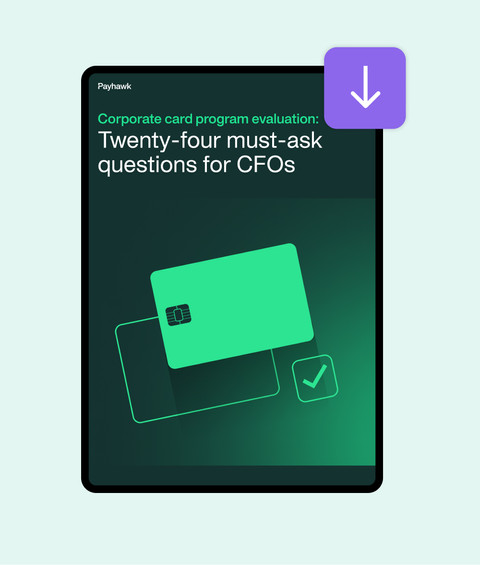
Spend management systems: How to get CFO buy in



Discover how to make a solid case for upgrading your spend management system in three simple steps. From checking your current costs, uncovering potential benefits, and figuring out the overall advantages with financial metrics, this blog is packed with practical advice on how to prepare a business case for switching solutions.
By submitting this form, you agree to receive emails about our products and services per our Privacy Policy.
While they may be accounting experts, the person in charge of finding a new expense management system doesn’t always know how to explain the hidden costs of outmoded financial software to executives. The need to change software might be abundantly clear, but the C-suite has other fires to put out and might not see the value in changing solution(s) without a more solid business case and good payback estimates.

Building a business case for upgrading your spend management system boils down to three key steps:
- Add up how much you're paying for your spend management system(s) today
- Estimate how much your new preferred spend management system will benefit your organization
- Calculate the financial benefits of your new spend management system
Looking for something more than three steps? You'll find plenty of in-depth, comprehensive templates online if you're looking to build a compelling business case. The job hunt site Indeed is one example, and the project management software developer Planio is another. The problem with these is that they cover too much.
Step 1: Add up how much you’re paying for your spend management system(s) today
Let’s start with the obvious: your current software costs. Start by collecting data on how much you’re spending on your present expense management system.
Software Costs: Direct subscriptions and licenses (easiest to gather)
You should be able just to plug last year’s subscriptions and licenses into an Excel tab, summing up the total costs at the bottom. But when calculating these - you need to present a forward-looking timeline. Will the current year with your current provider(s) cost the same, or will you need to factor in some contract price raises? Software prices can rise due to contractually specified uplifts, planned upgrades, an increase in seats, or some other reason. Be sure to model those increases on a longitudinal model if possible.
Pro tip: Business case models typically span five years, though some opt for three. Stick to cash costs when making your business case and avoid detailed discussions on depreciation and amortization. Plus, make it clear that your analysis doesn't include inflation, interest rates, or currency changes.
Also, consider how many different accounting and finance software packages your organization needs to licencse with your current setup. Purchasing an all-in-one spend management solution is often more cost-effective.
Labor Costs: Don’t forget the cost of the people using the software
Labor costs are connected to your spend management system in two ways.
Number one:
How much is your software solution(s) currently costing you per seat or per platform? And will it be cost-effective as you scale? Adding new seats or paying for transactions may become more untenable as your company scales.
Number two:
The actual human labor costs. If your current setup involves paying employees and coworkers to run through manual processes and complete multiple checks and manual work, you’re not getting good value for money. You may be paying people (including funding workstations, etc) for tasks that could be automated and pulling them away from more valuable, important work.
Try to put your finger on the cash compensation for this, but don’t get too far into the weeds; pick a defensible number and add that in.
Take Nick Millard, VP of Finance, GDS Group, for example:
Since we've implemented Payhawk, the benefits have been enormous. Before Payhawk, it used to be one person's full-time job to chase receipts, code credit card statements to the P&L, and manage costs and credit cards… Payhawk lets us be much more forward-facing. The person who used to chase receipts full-time now has an entirely different role. They can be proactive, track costs, and get visibility of expenses as they happen.
Step 2: Estimate how much your preferred spend management system will benefit your organization
Assuming you’ve chosen your preferred vendor and gathered all the details on what you’re currently paying, it’s time to figure out exactly how much your chosen solution could benefit you.
Krasimir Angelov, European Finance Manager & Managing Director at digital agency FFW, describes how this process looked for them.
We went through a process of evaluating different expense management solutions. For us, we wanted an all-around solution that could work for multiple locations, jurisdictions, and currencies and would add value to our organization and financial processes... We chose Payhawk as it integrates with our other software tools, including our (ERP) accounting system, travel booking solution, and banks, etc. The embedded technologies such as the OCR also allow us to reduce the time we spend processing and entering data massively.
Pro tip: Don’t make the “magic wand” assumption that you’ll realize all savings the minute you implement a new spend management system. Phase in the savings across the timeline based on realistic projections.
Is the new spend management solution cheaper?
Is the new package less expensive per seat or transaction, and if so, by what percentage? And/or is it easier to work with? If so, you might not need to add as many more seats as you planned for the current state.
David Watson, Group Financial Controller at State of Play Hospitality, describes the importance of cost breakdowns for them when it came to choosing a solution that would support their scaling.
We’re currently a group with six component entities, but as we expand, the need to pay per platform will only increase. That’s what really sold Payhawk to us. We pay per platform rather than per transaction, which is vital to us as a hospitality business.
Does the new software require less manual work?
If your new software requires less work, it may mean you can afford to pay for fewer seat licenses or that you can redirect some of your person-hours to other important tasks.
The new software could streamline management, even to the point where your finance team could start supporting outside of traditional financial controller duties.
Carolina Einarsson, Finance Director at UK/US behavioral analytics firm Essentia Analytics, explains how this looks for them since switching to us.
Saving time with Payhawk is a game changer; we've even been able to allocate resources to revenue-impacting teams — we now have a finance employee who spends 50 % of her time supporting as an SDR.
Whether your new software enables seamless automation or provides corporate cards that streamline processes by eliminating approvals, you should capture these benefits in your business case.
If the target state would routinise payment of irregular expenses, thus reducing management time, that's another biggy to tell the CFO, too.
Louis Gossieau, Head of Buyer Marketing at Mercell Nederland, says:
We use Payhawk for our online ad services and other irregular marketing expenses. As a marketer, you often want to order print materials, try out a little app, or upgrade a service. Now, instead of reaching out to Finance for a verification code or payment details, I can use the Payhawk Debit Card in my Apple Wallet to complete any purchase. Later, I'll upload the invoices in the app or forward them to the receipts mailbox for automated matching. It works like a charm!
Direct benefits: Remember why you want that new software in the first place
Ultimately, you’re not doing this just to save money. For fast-moving, scaling companies, price is important but it’s not everything. If there aren’t any further benefits outside of “savings” then switching solution(s) might not be worth the disruption, whatever the nickels and dimes might tell you.
It should automate the workload, making transaction processing faster and more accurate. This means not only less rework — which is captured in the labor savings — but also a barrier against paying questionable invoices or double-paying legitimate ones.
Plus, by gaining greater control over your company’s cash flow via smart card controls and/or our purchase order features, as well as invoice approval workflows, your cost of capital should decrease while your policy compliance goes up.
Step 3: Calculate the benefits of your new spend management system
Here’s where we turn accounting-speak into finance-speak.
You’re probably aware of the concepts of net present value (NPV), internal rate of return (IRR) and payback period. These are how financial executives weigh the relative value of projects across departments and lines of business. NPV tells them how much money they’d have to deposit in the bank today to realize the benefits of your project. IRR tells them how high an interest rate the bank would have to yield to realize those same benefits. And the payback period is the length of time it takes to break even on the project.
Pro tip: These are easy to calculate. Just use Microsoft Excel’s NPV and IRR functions, then follow Investopedia’s simple guide to calculating the payback period. To calculate NPV, you’ll need a “discount rate” to approximate your cost of capital; ask your executive’s office for this percentage.
When it comes to investigating a new spend management solution in particular, it pays to check on how long it typically takes them to breakeven for their customers. At Payhawk, our G2 customer data reveals:
- 38% faster time to value than competitors in the G2 Expense Management category (ten months for Payhawk, compared to 13.8 months average for other competitors)
- Average ROI of ten months (with 40% of our customers achieving ROI in under six months)
The above stats have been calculated by calculating the average Time To Value across all competitors on G2 Crowd. For side-by-side competitor comparison, please refer to the Competitive Comparison Stats page.
Beyond the numbers for C-suite, make sure you get a few peer reviews to add to your business case to demonstrate how your preferred solution is already helping other industry names scale and stay competitive.
Making your new spend management system a reality
In a nutshell, crafting a compelling business case for upgrading your spend management system boils down to three simple steps: evaluating current costs, exploring potential benefits, and calculating overall advantages. By considering both financial and operational gains, you can drive positive change in your organization's expense management practices.
Ready to take the next step? Book a demo today, and let us help you transform your spend management system.
Trish Toovey works across the UK and US markets to craft content at Payhawk. Covering anything from ad copy to video scripting, Trish leans on a super varied background in copy and content creation for the finance, fashion, and travel industries.
Related Articles


Sage Intacct integrations with spend management: Worth it?

